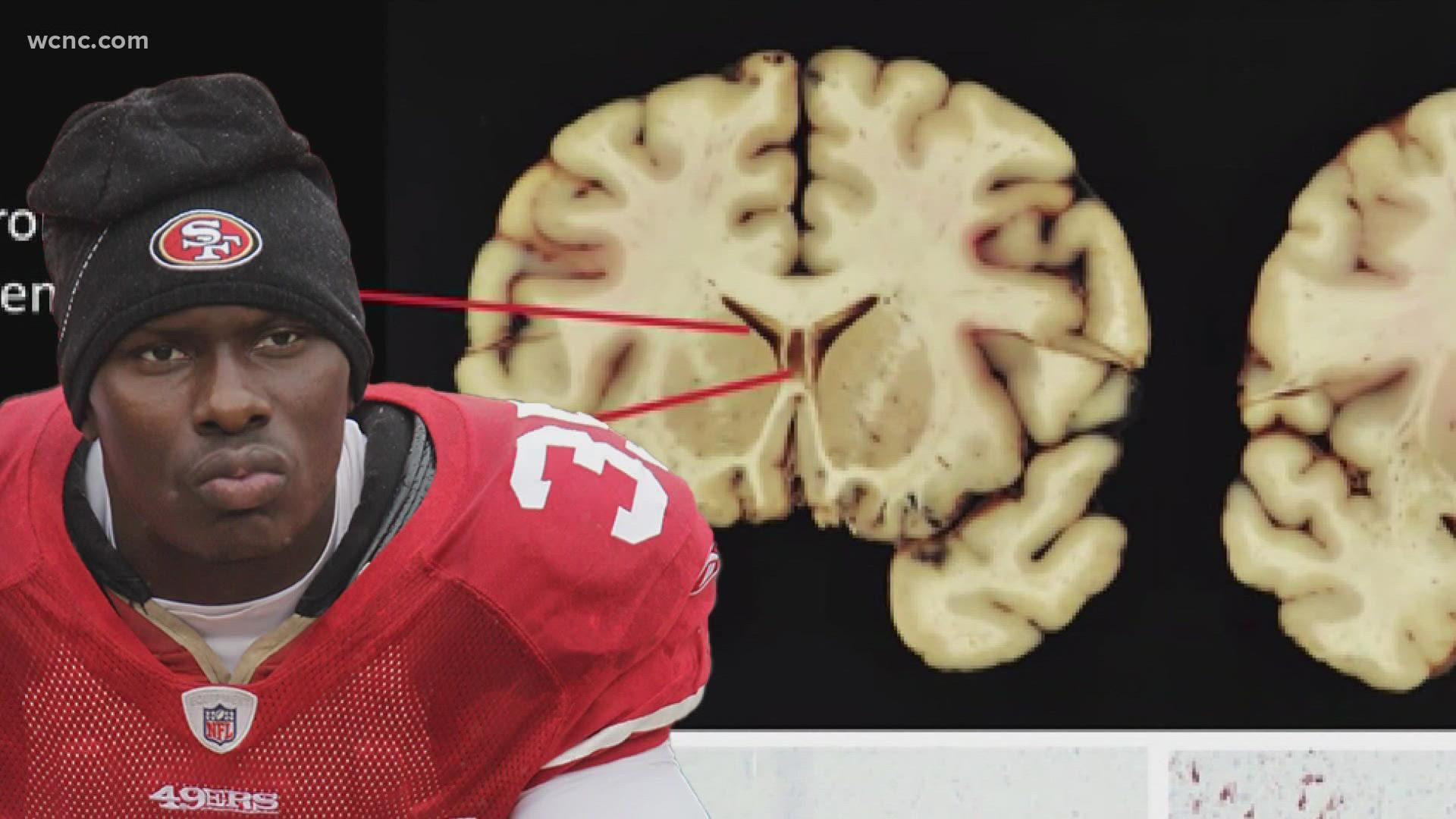ROCK HILL, S.C. — Phillip Adams, a former NFL player accused of killing six people in a mass shooting in Rock Hill before taking his own life in early April, showed signs of severe brain damage caused by CTE, a researcher from Boston University said Tuesday.
Dr. Ann McKee, a neuropathologist and expert on neurogenerative diseases at Boston University, said Adams had severe CTE in both frontal lobes of his brain. Dr. Sabrina Gast, the York County coroner, said Adams' family told officials he had complained of excruciating pain, memory issues and difficulty sleeping late in life.
"His 20-year career put him at high risk for development of CTE," McKee, who conducted the study on Adams' brain, said. "It's a progressive disease that worsens with age. In many instances, it is a disease of the young."
Police say Adams shot and killed Robert Lesslie, 70, his wife Barbara Lesslie, 69, and two of their grandchildren, Adah, 9, and Noah, 5, as well as two HVAC workers, James Lewis, 38, and Robert Shook, 38 on April 7 in Rock Hill.
Police say Adams took his own life as officers were closing in on him. Adams was from Rock Hill. He played in the NFL six years, most recently with the Atlanta Falcons, until the 2015 season. He had several documented injuries in his career.
McKee went on to say that Boston University has diagnosed CTE in 700 individuals, including 315 former NFL players. She said that of 24 former NFL players who died in their 20s and 30s, most of them had Stage 2 CTE. McKee compared Adams' CTE pathology to that of former NFL player Aaron Hernandez, who was diagnosed with CTE after his death in 2017.
"Mr. Adams' CTE pathology was different than the other young NFL players with CTE," McKee said. "It was different in that it was unusually severe in both frontal lobes."
McKee said Stage 2 CTE is associated with aggression, impulsivity, depression, paranoia, anxiety, poor executive function and memory loss. She said Adams' 20-year football career undoubtedly contributed to CTE.
"We have seen this behavior. We have even seen homicidal behavior in individuals diagnosed with CTE. It is difficult to say that it alone resulted in these behaviors because usually, it's a complicated issue with many other factors," McKee said. "It is in fact, not what I would consider unusual in this disease."
A representative for Adams' family said he was "desperately seeking help" from the NFL but was denied all of his claims because he had trouble remembering things and struggled to complete simple tasks, such as traveling to visit doctors and undergo extensive testing.
The family issued the following statement:
"As we process these results, we are deeply saddened by the events that occurred on April 7 and we continue to pray for the families of the victims. We are pleased to have a better understanding of the mental turmoil that Phillip was dealing with during the last moments of his life.
We cannot say that we are surprised by these results, however, it is shocking to hear how severe his condition was. After going through medical records from his football career, we do know that he was desperately seeking help from the NFL but was denied all claims due to his inability to remember things and to handle seemingly simple tasks such as traveling hours away to see doctors and going through extensive evaluations.
We now know that these deficits were most likely caused by the disease. By participating in the research process, we hope to bring awareness to this condition so that players young and old can understand the risks. We will continue to advocate for any research that can prevent any other families from having to endure this type of tragedy We want people to understand that this could happen to anyone. Phillip is not the first to battle this disease and he will not be the last
Thank you so much to Boston University the Concussion Legacy Foundation. the VA, and all of the folks that have helped its and many other families to get these much-needed answers."
The NFL released a statement Wednesday in regard to the report:
"We appreciate the work done by Dr. McKee and her colleagues for the value it adds in the ongoing quest for a better understanding of CTE. Case studies such as those compiled in this updated paper are important to further advancing the science and progress related to head trauma. The medical and scientific communities will benefit from this publication and the NFL will continue to work with a wide range of experts to improve the health of current and former NFL athletes. As noted by the authors, there are still many unanswered questions relating to the cause, incidence and prevalence of long-term effects of head trauma such as CTE. The NFL is committed to supporting scientific research into CTE and advancing progress in the prevention and treatment of head injuries.
"In 2016, the NFL pledged $100 million in support for independent medical research and engineering advancements in neuroscience-related topics. This is in addition to the $100 million that the NFL and its partners are already spending on medical and neuroscience research."
Following the shootings, Gast obtained special permission to have Phillips' brain tissue sent in for CTE tests. CTE, or Chronic traumatic encephalopathy, is a brain degeneration most likely caused by head trauma, according to the Mayo Clinic.
According to doctors, CTE has been found in professional athletes and symptoms include cognitive, behavioral and mood changes. Right now, the disease can only be diagnosed after death, when doctors use a sample of brain tissue to study the brain.
“Many of the individuals who were diagnosed with CTE in life they had what we call emotional lability, which is basically like a short fuse or flying off the handle quickly," said Dr. Dan Daneshvar with Harvard Medical Schoo, "These were often significant personality changes from what the individual and their loved ones previously recorded.”
Daneshvar has studied CTE for 12 years. He says the medical community has known about the disease since the 1920’s, but it started receiving more attention in the last decade when doctors started finding it in football players.
A study published in 2017 showed out of 111 NFL players whose brains were donated for CTE testing, 110 were found to have had the disease.
“We found that playing additional years of football was associated with a higher risk of an individual getting CTE, to the tune of every additional year of football, regardless of level of play, and regardless of position play, in that study, we found was associated with a 30% increased risk of CTE," said Daneshvar.
But Daneshvar says anyone who is repeatedly hit in the head is at risk of CTE, including boxers and victims of domestic violence.
Eight months after the fatal shootings, questions about the motive for the murders remain. When police searched Dr. Lesslie’s office, they found no evidence Phillip Adams was his patient.
Wake Up Charlotte To Go is a daily news and weather podcast you can listen to so you can start your day with the team at Wake Up Charlotte.
SUBSCRIBE: Apple Podcasts || Spotify || Stitcher || TuneIn || Google Podcasts
All of WCNC Charlotte's podcasts are free and available for both streaming and download. You can listen now on Android, iPhone, Amazon, and other internet-connected devices. Join us from North Carolina, South Carolina, or on the go anywhere.


